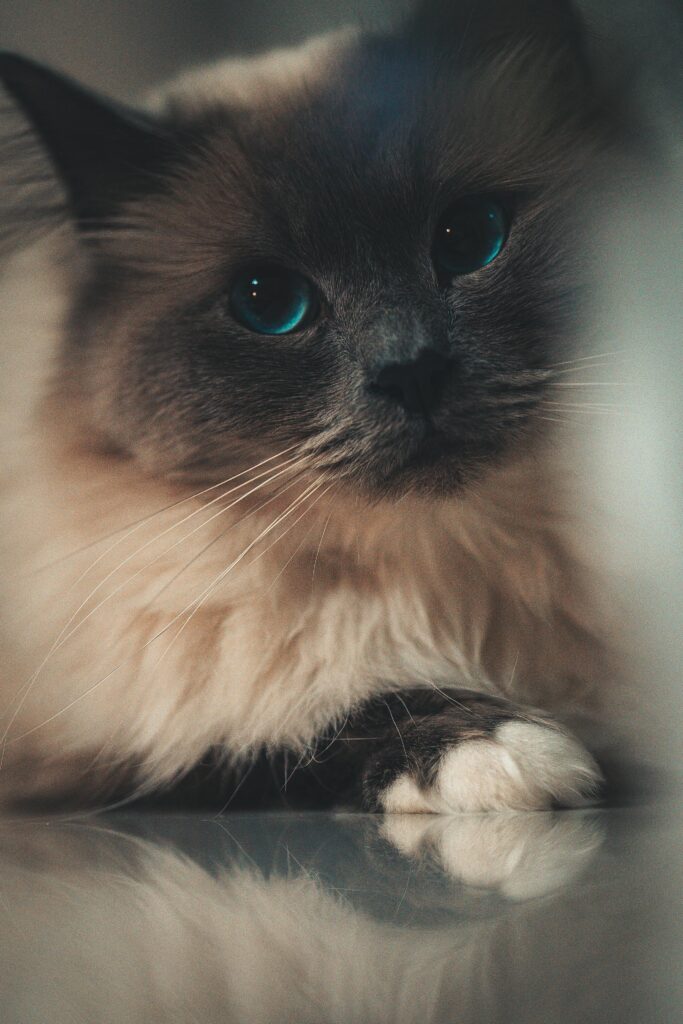
THE MINK RAGDOLL CAT: COMPLETE GUIDE TO THE RAGDOLL MINK
When most people picture a Ragdoll cat, they imagine bright blue eyes and a pale body with dark points. But not every Ragdoll fits the classic pointed pattern. Some come with a deeper, richer look — velvety coats, aqua eyes, and full-color shading that tells a fascinating genetic story.
This beautiful variation is the Mink Ragdoll. Mink Ragdolls belong to the extended Ragdoll family recognized by TICA under the Cherubim classification, which includes non-traditional Ragdoll coat expressions such as minks, sepias, and solids. While minks cannot compete in traditional pointed show classes, they are still purebred, pedigreed Ragdolls with the same lovable temperament, soft coats, and affectionate nature.
In this guide, we explore everything that makes the Mink Ragdoll cat unique — from genetics and appearance to care, personality, colors, and how to find a reputable mink Ragdoll kitten.
Mink Ragdoll Overview
| Trait | Description |
|---|---|
| Breed Type | Purebred Cherubim Ragdoll (recognized by TICA) |
| Common Name | Mink Ragdoll or Ragdoll Mink |
| Coat Pattern | Full-body color with darker points and rich shading |
| Coat Type | Semi-long, soft, and velvety |
| Eye Color | Aqua or teal, sometimes mint-green tones |
| Temperament | Gentle, affectionate, calm, and people-oriented |
| Rarity | Uncommon compared to traditional pointed Ragdolls |
| Kittens Born | Born with visible color at birth, unlike pointed kittens |
| Registry | Accepted by TICA as part of the Cherubim group |
| Lifespan | 12–16 years with proper care |
Looking for a Ragdoll Kitten?
If you’re hoping to welcome a sweet, floppy Ragdoll into your home, check out our Newest Ragdoll Kittens!
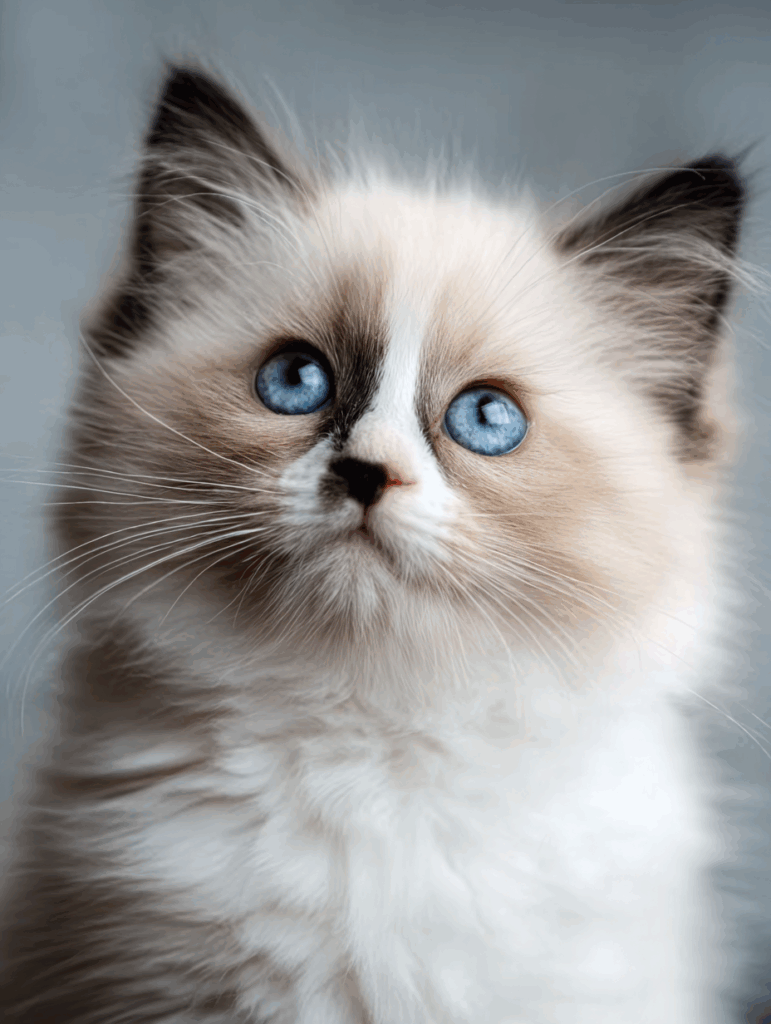
At Almonte Cats, each kitten is:
- TICA and CFA registered from fully health-tested Ragdoll parents
- Raised in-home for gentle, people-loving temperaments
- Vet-checked, vaccinated, and microchipped before going home
We raise only a few litters each year to maintain quality, structure, and true Ragdoll personality.
Reserve early — our kittens are often spoken for before they are eight weeks old.
👉 View Available Ragdoll Kittens & Apply Here
Can Ragdolls Be Mink?
Yes. Ragdolls can carry the mink gene, which creates a richer coat and deeper shading. Traditional Ragdolls have the genotype cs/cs, which produces pointed coloring. Mink Ragdolls carry cs/cb, a combination of the colorpoint gene and the Burmese gene. This creates the signature mink look.
Unlike pointed Ragdolls, mink kittens are born with visible color. Their coats deepen as they grow, producing a velvety, plush texture that feels different from the standard pointed coat. Their eyes often shine in aqua or teal, which adds to their exotic beauty.
Mink is not a separate breed. It is a genetic expression within the Ragdoll gene pool.
What Is a Mink Ragdoll Cat?
A Mink Ragdoll is a purebred Ragdoll with deeper body color, darker shading, and a richer coat texture. Their appearance stands between a traditional pointed Ragdoll and a sepia Ragdoll. Mink Ragdolls still carry the gentle, floppy, people-loving personality Ragdolls are famous for.
Typical features include:
• Full-body color from birth
• Velvety coat texture
• Aqua or teal eyes
• Darker shading on points
• A warm, luxurious coat tone
Their deeper color and bright eyes create a dramatic, photogenic look that many families adore.
Are Mink Ragdolls Purebred?
Yes. Mink Ragdolls are purebred Ragdolls as long as both parents are registered Ragdolls. The difference lies only in the genetics that influence coat depth and eye color.
Under TICA, mink Ragdolls belong to the Cherubim Ragdoll group, which includes:
• Mink
• Sepia
• Solid
This grouping protects the genetic variation within the breed and supports pedigree tracking. The mink Ragdolls maintain the same structure, temperament, and health expectations as all Ragdolls.
Mink Ragdoll Kitten Appearance
Mink Ragdoll kittens are born with color, unlike pointed kittens who start white. You can see their rich coat from day one. Their color intensifies as they grow.
Common mink patterns include:
• Mink colorpoint — dark points with an even, rich body color
• Mink mitted — white mittens with darker shading and full-body tone
• Mink bicolor — softened V-mask with deeper color than pointed bicolors
• Mink lynx — tabby striping layered on a mink base coat
As they mature, their coats develop a smooth, plush texture that many owners describe as suede-like. Their eyes often settle into stunning aqua tones around 6–8 months.
Mink Ragdoll Temperament
Mink Ragdolls share the same classic Ragdoll personality:
• Affectionate
• Calm
• Gentle
• People-focused
• Easy to handle
• Great with kids and pets
Mink Ragdolls stay close to their people and rarely miss a moment of household activity. They enjoy gentle cuddles, quiet play sessions, and daily interaction. With the right introductions, they adapt well to calm homes, active households, and families with children.
Their personality does not differ from pointed Ragdolls. Mink simply affects coat color, not temperament.
Eye Color in Mink Ragdolls
Traditional pointed Ragdolls always have blue eyes. Mink Ragdolls show more variety:
• Aqua
• Teal
• Seafoam
• Mint-toned blue-green
This is one of the mink Ragdoll’s most striking features. Their eye color often glows in sunlight and photographs beautifully.
The Genetics Behind Mink Ragdolls
A mink Ragdoll carries the genotype cs/cb, which is a blend of:
• The Burmese color gene
• The Siamese colorpoint gene
This combination produces:
• Richer full-body color
• Aqua eyes
• Faster color development
• A velvety coat
Mink Ragdolls stay genetically purebred. Their coat depth simply reflects a genetic variation present in the early Ragdoll foundation lines.
Mink Ragdolls in TICA
TICA recognizes mink Ragdolls under the Cherubim Ragdoll group, which includes non-traditional Ragdolls such as minks, sepias, and solids. This classification matters because it protects their lineage while keeping them connected to the official Ragdoll breed. Although mink Ragdolls cannot compete in the traditional pointed Ragdoll show ring, they still qualify for several exhibition pathways within TICA. These include New Traits, Exhibition, and Household Pet divisions, which allow owners to show their mink cats, display correct type, and receive feedback from judges.
Because mink Ragdolls do not express the temperature-sensitive pointed gene, they fall outside the original Ragdoll standard. However, TICA’s Cherubim class for non-pointed Ragdolls, maintains that breeders can continue developing and preserving these lines responsibly. This support allows minks to maintain their place within the broader Ragdoll family instead of becoming mislabeled or lost across generations. Registration also ensures accurate record-keeping, verified parentage, and long-term breed integrity.
If you want to learn more about how TICA categorizes minks, sepias, solids, and other non-pointed varieties, you can explore my full guide on Cherubim Ragdolls. It explains the entire classification system and shows where mink Ragdolls fit within TICA’s structure. Read the Cherubim Ragdoll guide here.
How Rare Are Mink Ragdolls?
Mink Ragdolls are uncommon because many breeders focus on traditional showable colors. Producing high-quality mink kittens requires careful selection, strong pedigrees, and dedicated breeding plans.
Their rarity and dramatic appearance make them very desirable among Ragdoll lovers who want something unique yet authentic.
Grooming and Coat Care
Mink Ragdolls have the same semi-long coat as pointed Ragdolls, but it often feels more velvety.
Care tips include:
• Brush two to three times weekly
• Use a stainless-steel comb
• Maintain high-quality nutrition
• Keep coat hydrated with gentle grooming products
Their darker coats hide dirt well but still need regular maintenance.
Health and Lifespan
Mink Ragdolls share the same strong health foundation as traditional Ragdolls. Because they come from the same breed lineage, they benefit from generations of selective breeding, steady temperaments, and predictable traits. Responsible breeders protect these cats through strict health testing, which helps maintain longevity and overall wellness. Every reputable Ragdoll program screens for HCM and PKD, since these conditions appear within the wider Ragdoll breed. Testing removes high-risk lines, improves genetic strength, and supports healthier future kittens.
With proper care, most Mink Ragdolls live twelve to sixteen years, and many enjoy even longer lifespans. High-quality nutrition, regular veterinary checkups, and a clean indoor lifestyle add several years to their expected life. Although minks display richer coats and aqua eyes, they hold no added health risks tied to color. Their wellness depends entirely on breeding practices, early care, and lifelong management.
Owners can support longevity by maintaining healthy weight, offering enrichment, and scheduling routine vet appointments. Ragdolls thrive in calm homes with steady routines, so consistent daily habits also promote emotional health. When breeders test carefully and families provide attentive care, Mink Ragdolls live long, affectionate, and rewarding lives.
Finding a Mink Ragdoll Kitten
Mink Ragdoll kittens are not widely produced. You may need to reserve early.
Look for breeders who:
• Register with TICA or CFA
• Provide health testing
• Offer pedigrees
• Raise kittens in-home
• Avoid marketing mink as “rare designer colors”
Many sellers misuse the term “mink” to describe mixed-breed cats. Authentic mink Ragdolls require proof.
At Almonte Cats, we occasionally produce mink Ragdoll kittens from carefully selected lines. Each kitten receives the same quality care, socialization, and health testing as our traditional colors.
Mink Ragdolls vs. Traditional Ragdolls
| Feature | Mink Ragdoll | Traditional Ragdoll |
|---|---|---|
| Registry Class | Cherubim (Non-pointed) | Traditional (Pointed) |
| Body Color | Deep, rich shading | Pale body |
| Eye Color | Aqua or teal | Blue |
| Coat Texture | Velvety and plush | Silky and soft |
| Birth Color | Born colored | Born white |
| Show Eligibility | New Traits classes | Full Ragdoll show divisions |
| Rarity | Uncommon | Widely bred |
Are Mink Ragdolls the Same as Sepia Ragdolls?
No. Sepia Ragdolls carry cb/cb, which produces an even darker, richer coat. Minks sit between pointed and sepia on the color spectrum.
Mink Ragdolls and Sepia Ragdolls belong to the same extended Ragdoll family. They both fall under the TICA Cherubim Ragdoll group, which includes mink, sepia, and solid variations. Many people confuse the two, but their genetics differ in clear and important ways. Each type carries a specific genetic code that controls how pigment forms across the coat.
Mink Ragdoll vs Sepia Ragdoll DNA
Mink Ragdolls carry the genotype cm/cs.
This means they inherit one mink gene (cm) and one colorpoint gene (cs). The combination creates a coat that appears darker than a pointed Ragdoll, but lighter than a sepia Ragdoll. Mink coats feel warm and velvety. They often show medium-strength pigment from birth. These cats also develop aqua eyes, which is a signature trait of mink expression. Their color deepens with age but still shows contrast between the body and points.
Sepia Ragdolls carry the genotype cb/cb.
They do not carry the colorpoint gene. Instead, they hold two copies of the “Burmese” sepia gene (cb). This creates the darkest possible coat within the Ragdoll gene family. Sepia Ragdolls display deep, rich pigment across the whole body. The color can appear almost chocolate-like in depth. Sepias often develop green, gold, or intense aqua eyes. Their coats feel extremely plush and dense due to full-body pigment.
The key difference sits in the amount of pigment dilution. Mink Ragdolls have partial dilution because they hold the cs gene. Sepia Ragdolls show almost no dilution because they carry two cb genes. This explains why sepia coats appear much darker than mink coats.
In summary, minks sit between pointed and sepia Ragdolls in both color and genetics. Sepias represent the darkest end of the Cherubim spectrum. Both types remain rare and require careful, responsible breeding.
Why Mink Ragdolls Are Gaining Popularity
Social media has helped boost their recognition. Their dramatic color, bright eyes, and plush coats photograph beautifully. Owners also love their calm personalities and easygoing nature. And some people enjoy having a chocolate colored Ragdoll version, they look exotic.
Mink Cat Breeds
The mink gene appears almost exclusively in Ragdolls. Many people misuse the phrase “mink cat,” but true mink expression comes from registered Ragdoll lineage. Only cats with documented mink ancestry and proper registration carry the correct genetic markers. Other breeds do not carry authentic mink lines, so the term should not apply outside the Ragdoll community. This is why clear pedigree proof matters.
Mink Ragdolls stand out because of their rich shading, silky coats, and striking aqua eyes. Their coats feel slightly softer and thicker than traditional pointed Ragdolls. Their color appears deeper and smoother from birth, unlike pointed kittens that start white. This rich tone creates a dramatic, velvety look that attracts many buyers. Minks often show better contrast in photos and appear more vibrant in person.
Mink Ragdoll kittens remain rare because responsible breeders protect the mink gene carefully. They track pedigrees, test genetics, and avoid mislabeling to keep the lines strong. Families who want a mink Ragdoll must work with a breeder who understands mink development and color accuracy. A reputable mink breeder provides registration, DNA details, and documented lineage. This protects your investment and ensures you receive a genuine mink Ragdoll with strong health and a predictable temperament.
Mink Ragdoll Kittens
Mink kittens show color immediately at birth. They never start pure white like traditional pointed Ragdoll kittens. Their coats begin with warm shading that deepens over time. This early color makes mink kittens easy to identify for experienced breeders. As they grow, their coats develop a rich, plush texture. The fur often feels thicker, softer, and warmer than standard Ragdoll coats. Many owners describe mink coats as silky, dense, and velvet-like.
Mink kittens keep the classic Ragdoll personality. They stay gentle, relaxed, and affectionate. They bond easily with their families and enjoy calm homes. Most mink kittens adapt well to children, seniors, and cat-friendly dogs. Their temperament reflects their Ragdoll heritage, not their color. The mink gene does not change personality. Good breeders select for temperament, which keeps these kittens steady and social.
Because mink kittens are rare, most breeders maintain waitlists. Demand often exceeds supply, especially for seal mink, blue mink, and mink mitted kittens. Early reservation increases your chances of getting the pattern and color you want. Many families join waitlists months before kittens arrive. If you want a specific mink Ragdoll color, such as seal mink mitted or blue mink bicolor, plan ahead and work with an established breeder.
Mink Ragdoll Color Comparison Graph
Mink Ragdoll Color Comparison
| Color | Body Tone | Point Color | Eye Color | Born With Color? | Coat Depth | Notes |
|---|---|---|---|---|---|---|
| Seal Mink | Warm brown body | Deep seal points | Aqua | Yes | Very deep | Most common mink color |
| Blue Mink | Cool slate body | Soft blue-gray points | Aqua | Yes | Medium | Elegant cool-toned mink |
| Chocolate Mink | Warm milk chocolate body | Soft chocolate points | Aqua | Yes | Medium | Rare warm-toned mink |
| Lilac Mink | Pale frosted body | Icy lilac points | Aqua | Yes | Light | Softest mink shade |
| Flame Mink | Cream body | Red-gold points | Aqua | Yes | Medium | Bright warm tones |
| Cream Mink | Light cream body | Pastel cream points | Aqua | Yes | Light | Soft pastel mink color |
| Seal Mink Lynx | Striped warm body | Seal lynx striped points | Aqua | Yes | Deep | Strong lynx patterning |
| Blue Mink Lynx | Cool slate body | Blue lynx striped points | Aqua | Yes | Medium | Soft gray striping |
| Seal Mink Bicolor | Warm brown body | Bicolor mask | Aqua | Yes | Medium-deep | Rare and striking |
| Blue Mink Bicolor | Cool slate body | Blue bicolor mask | Aqua | Yes | Medium | Popular mink variation |
| Seal Mink Mitted | Warm brown body | Seal points with mittens | Aqua | Yes | Deep | Balanced pattern with white mitts |
| Blue Mink Mitted | Cool slate body | Blue points with mittens | Aqua | Yes | Medium | Very photogenic pattern |
| Sepia Ragdoll | Rich warm body | Deepest pigment | Gold/Green/Aqua | Yes | Very deep | Darkest mink variant |
Blue Mink Ragdoll Cat
A blue mink Ragdoll cat carries the mink gene plus the blue dilution gene. This creates a rich smoky-blue coat with deeper shading than traditional blue points. Blue mink coats look plush, smooth, and velvety. The color feels soft but more pigmented than pointed coats.
Blue mink Ragdolls often show aqua eyes instead of traditional blue. Many owners love the glowing appearance of mink eye color. The blue mink coat keeps a consistent tone across the body. It does not display the sharp contrast seen in colorpoint cats. This creates a luxurious, shaded look.
Blue mink Ragdoll cats fit well in homes that enjoy unique coat colors. They carry the same gentle temperament as all Ragdolls. They show calm behavior, soft voices, and strong family attachment. If you want a deeper blue coat with a smooth visual texture, a blue mink Ragdoll offers a striking option.
Seal Point Mink Ragdoll
A seal point mink Ragdoll combines the seal gene with the mink gene. Seal creates a deep warm brown tone. The mink gene softens it into a shaded, chocolate-rich coat. This gives the cat a warm, earthy look.
Seal point minks show deeper color on the face, tail, and paws. The body carries a strong shaded brown tone. This creates a smooth blend with no harsh contrasts. Eye color often appears aqua or teal.
Families who love darker tones often choose seal point minks. These cats stay affectionate, calm, and loyal. They enjoy gentle homes and regular interaction. Their warm brown shading creates one of the richest coat colors in the mink spectrum.
Sepia Mink Ragdoll
A sepia mink Ragdoll carries two copies of the Burmese gene. This creates the darkest version of mink. The coat appears deep, warm, and striking. Sepia coats show strong color coverage with rich shading across the entire body.
Sepia Ragdolls often develop gold or green eyes. Their coats feel smooth, silky, and thick. The sepia tone stays consistent year-round. These cats never show the pale bodies seen in pointed Ragdolls.
Sepia minks attract families who want bold and intense colors. The combination of temperament and deep pigmentation creates a rare and stunning Ragdoll type. Sepia remains uncommon, so early reservation is recommended.
Seal Mink Ragdoll
A seal mink Ragdoll carries warm brown shading with a mink overlay. The coat shows medium-to-dark tones with a soft, velvety finish. Seal minks display color across the body and points.
Seal mink Ragdolls stay popular because their shading looks rich but not overly dark. They show warm brown tones around the face, tail, and legs. Their bodies stay shaded with a soft gradient.
These cats make wonderful companions. They follow their owners closely, enjoy grooming, and relax well in home environments. Seal mink offers a beautiful, balanced color option with strong visual appeal.
Mink Point Cat
A mink point cat describes any Ragdoll carrying the mink gene plus pointed expression. Their points appear darker than the body, but the shading blends more smoothly than traditional colorpoints.
Mink point coats show:
• Rich shading
• Soft transitions
• Warm undertones
• Velvety texture
Mink point Ragdolls display aqua eyes rather than vivid blue. Many families love the gemstone-like look. Mink point cats stand out due to their depth of color and plush coats.
Cream Mink Ragdoll
A cream mink Ragdoll carries the red gene plus the mink gene. This creates a warm, peach-toned coat. Cream minks appear soft, glowing, and warm. Their shading stays light but richer than pointed creams.
These kittens often show coral or peach undertones. Their coats feel dense and plush. Cream minks attract families who love soft, warm pastel colors.
Cream mink Ragdolls keep the same calm temperament as all Ragdolls. They love affection, quiet homes, and gentle routines. If you want a warm pastel color, cream mink Ragdolls offer a rare and beautiful choice.
Seal Mink Mitted Ragdoll
A seal mink mitted Ragdoll carries the seal gene, mink gene, and white spotting pattern. This creates a warm, shaded brown coat with bright white mittens. Many owners love the contrast between deep shading and white feet.
Seal mink mitted cats often show a white chin or belly stripe. Their bodies stay shaded with warm tones. Their mittens highlight their paws and add charm.
Families who want a combination of color and white often choose this pattern. Seal mink mitted Ragdolls look elegant and stay very photogenic.
Blue Mitted Mink Ragdoll Cat
A blue mitted mink Ragdoll cat combines the blue dilution, the mink gene, and white spotting. This creates a cool-toned shaded blue body with white mittens. The coat appears smooth and luxurious.
Blue mitted minks show strong shading on the tail and face. Their bodies stay cool-toned with beautiful depth. Aqua or blue-green eyes complete the look.
This combination of shading and white makes the blue mitted mink one of the most eye-catching mink varieties.
Seal Mink Bicolor Ragdoll
A seal mink bicolor Ragdoll carries seal pigment, mink shading, and bicolor white patterns. This cat displays a warm brown coat with an inverted V mask, white legs, and shaded points.
This pattern blends the deep seal color with large white areas. The mink gene enriches the shading, creating a balanced and attractive look. Many families prefer this pattern because of its contrast and elegance.
Seal Mink Lynx Ragdoll
A seal mink lynx Ragdoll displays striping on the face, legs, and tail. Lynx adds a tabby pattern on top of the mink shading. This creates a striking combination of depth and pattern.
Seal mink lynx Ragdolls often look wild and expressive. Their stripes appear soft and blended. Their bodies stay shaded and smooth.
Families who love unique and dramatic looks often choose lynx minks.
Seal Colorpoint Mink Ragdoll
A seal colorpoint mink Ragdoll displays the deepest shading on the points. The face, ears, tail, and paws show dark brown tones with a soft mink overlay. The body shows warm shading.
This cat carries a rich and traditional look with enhanced depth. The mink gene softens harsh contrasts and creates a smooth gradient.
Seal colorpoint minks appeal to families who love deep tones but prefer a softer finish than standard colorpoints.
Bicolor Mink Ragdoll
A bicolor mink Ragdoll shows large white patterns with a shaded mink body. The inverted V mask appears over a deeper shaded face. The body displays warm or cool tones depending on the base color.
Bicolor minks offer a dramatic and friendly appearance. They keep the Ragdoll’s classic white pattern but add extra depth through mink shading.
Mink Ragdoll Cat Summary
Mink Ragdolls come from early Ragdoll foundation lines. They carry the “mink” gene, which produces richer, deeper colors and softer contrast. Minks keep the same sweet temperament as traditional Ragdolls but show fuller pigment and softer coats. Their eyes appear aqua rather than vivid blue. Many families love the mink look because it offers a luxurious, velvet-like style.
Mink Ragdoll kittens are born with visible color. They do not start white like pointed Ragdolls. Their coats darken early and stay dense through adulthood. Mink colors include seal mink, blue mink, chocolate mink, lilac mink, flame mink, cream mink, lynx mink, and bicolor mink. Each variation carries its own tone and shade strength.
Mink cats belong to the Cherubim Ragdoll group under TICA. They remain purebred Ragdolls with pedigrees, health testing, and correct structure. They simply express a different genetic style. Many buyers choose mink kittens for their bold pigment, aqua eyes, and plush coat texture.
20 FAQ About Mink Ragdoll Cats
1. What is a Mink Ragdoll cat?
A Mink Ragdoll carries a special gene that creates a richer coat color and a warm, velvety texture. Unlike traditional pointed kittens, minks show color at birth and deepen as they grow. Their eyes often appear aqua rather than blue. This combination makes them stand out while still keeping the classic Ragdoll temperament.
2. Are Mink Ragdolls purebred Ragdolls?
Yes. Mink Ragdolls come from documented Ragdoll lines and are purebred when registered correctly. Some confusion exists online, so verified pedigrees matter. Reputable breeders track mink lineage through TICA or CFA for accuracy and transparency.
3. Do all Ragdoll breeders produce mink kittens?
No. Many breeders focus only on traditional pointed lines. Mink lines require intentional planning and preservation. Because of this, not all catteries offer mink kittens, and availability varies greatly.
4. Are mink kittens born white like pointed kittens?
No. Mink kittens show visible color at birth, which helps owners identify patterns early. Their coats darken gradually through the first year. This early pigmentation is one of the easiest ways to distinguish minks from traditional kittens.
5. What eye color do Mink Ragdolls have?
Most Mink Ragdolls have aqua eyes, which is a hallmark of the mink expression. The shade can vary from pale teal to deeper blue-green. Eye color continues to enrich as the kitten matures. This unique tone is one of the reasons minks attract so much attention.
6. How does a Mink Ragdoll differ from a traditional Ragdoll?
Traditional Ragdolls start white and develop color over time. Minks begin life with immediate pigment and maintain a richer tone throughout maturity. Their coats also feel warmer, denser, and more velvety. Both types still share the same calm, affectionate temperament.
7. Are Mink Ragdolls rare?
Yes. Because mink requires specific genetic heritage, few breeders maintain established mink lines. Demand typically exceeds supply. As a result, most families need to join a waitlist to reserve one.
8. Are Mink Ragdolls the same as Sepia Ragdolls?
No. Although minks and sepias share Tonkinese-influenced ancestry, sepias express a much darker, richer coat. Minks sit between pointed and sepia on the pigmentation scale. Both types require cb-related genetics but display different depth and warmth of color.
9. What colors can Mink Ragdolls come in?
Minks appear in every standard Ragdoll color, including seal, blue, chocolate, lilac, flame, and cream. They also come in patterns such as mitted, bicolor, lynx, and colorpoint. The mink gene enriches every one of these colors. This creates deeper tones compared to non-mink cats.
10. How big do Mink Ragdolls get?
Mink Ragdolls grow to the same size as traditional Ragdolls. Most reach 10–20 pounds depending on gender and genetics. Growth continues steadily for three to four years. Their plush coats often make them look even larger.
11. Do Mink Ragdolls shed a lot?
They shed at a moderate level similar to standard Ragdolls. Regular brushing reduces loose hair and keeps the coat smooth. Because their fur is thicker and more velvety, maintaining a grooming routine improves coat health. Seasonal shedding also varies with climate.
12. Are Mink Ragdolls good with children?
Yes. Mink Ragdolls share the same patient, soft temperament as pointed Ragdolls. They adapt well to families who interact gently. Most minks enjoy play, closeness, and predictable routines.
13. Do Mink Ragdolls get along with dogs?
Usually yes. Many minks show confidence around calm, cat-friendly dogs. Proper introductions help them adjust without stress. Their relaxed nature supports multi-pet households.
14. Can Mink Ragdolls compete in cat shows?
Traditional Ragdoll show classes require blue eyes, so many minks do not qualify. However, some registries offer exhibition categories and new trait divisions. Minks remain purebred even when not eligible for pointed divisions. Their value comes from beauty and temperament, not show ranking.
15. What is the temperament of a Mink Ragdoll?
Mink Ragdolls behave like classic Ragdolls: sweet, loyal, and people-focused. They bond strongly with their families and follow their owners from room to room. Their confidence and warmth make them ideal companions. Many owners describe their minks as intuitive and emotionally aware.
16. Do Mink Ragdolls require special care?
Their daily care mirrors that of standard Ragdolls. Regular grooming, nutritious food, and routine veterinary visits support long-term health. However, their dense fur benefits from consistent brushing. This keeps the coat velvety and free of tangles.
17. Are mink kittens harder to find?
Yes. Because few breeders work with mink genetics, litters remain limited. Many breeders use waitlists to organize placements. Planning ahead increases your chances of securing your preferred color and pattern.
18. How much do Mink Ragdoll kittens cost?
Prices vary based on color, pattern, and pedigree. Most mink kittens cost more than standard pointed kittens due to rarity. Health testing and lineage also influence pricing. Reputable breeders provide full transparency on costs.
19. How long do Mink Ragdolls live?
Their lifespan averages 12 to 17 years, similar to pointed Ragdolls. Good nutrition, indoor living, and preventive vet care help them reach the upper end of the range. Responsible breeding also supports long-term health. Many minks live well into their senior years.
20. Where can I find Mink Ragdoll kittens for sale?
Because minks stay rare, the safest option is a reputable Ragdoll breeder with documented mink lines. This ensures correct lineage, health testing, and proper registration. Many families join waitlists months in advance. If you want a mink kitten, I can help guide you to available litters and quality programs.
How can I reserve one of your Ragdoll kittens?
Submit an adoption application on the Almonte Cats website. Approved families are matched by temperament and color preference. Early reservations are recommended due to limited availability.
See our Available Ragdoll Kittens for Sale Here.
Related Colors and Patterns
- Black Ragdoll Cat Color
- Chocolate Point Ragdoll Color
- Black and White Tuxedo Ragdolls
- Lilac Point Ragdoll
- How Much Does A Cinnamon Ragdoll Cost?
- Lynx Pattern Ragdoll Guide
- Blue Mitted Ragdolls
- Bicolor Ragdoll Kittens for Sale
Mink Ragdoll Cat Summary
Mink Ragdolls come from early Ragdoll foundation lines. They carry the “mink” gene, which produces richer, deeper colors and softer contrast. Minks keep the same sweet temperament as traditional Ragdolls but show fuller pigment and softer coats. Their eyes appear aqua rather than vivid blue. Many families love the mink look because it offers a luxurious, velvet-like style.
Mink Ragdoll kittens are born with visible color. They do not start white like pointed Ragdolls. Their coats darken early and stay dense through adulthood. Mink colors include seal mink, blue mink, chocolate mink, lilac mink, flame mink, cream mink, lynx mink, and bicolor mink. Each variation carries its own tone and shade strength.
Mink cats belong to the Cherubim Ragdoll group under TICA. They remain purebred Ragdolls with pedigrees, health testing, and correct structure. They simply express a different genetic style. Many buyers choose mink kittens for their bold pigment, aqua eyes, and plush coat texture.
At Almonte Cats, we raise Ragdolls for families who value beauty, temperament, and trust. Every kitten carries our promise of health, love, and lifelong support.
Sources & References
- The International Cat Association (TICA). “Ragdoll Breed Standard.”
https://tica.org/breeds/browse-all-breeds?view=article&id=859- Cat Fanciers’ Association (CFA). “Ragdoll Cat Breed Profile.”
https://cfa.org/ragdoll/- Ragdoll Fanciers Club International (RFCI). “Ragdoll Color and Pattern Guide.”
https://rfci.org/- Messybeast Cat Genetics. “Color Genetics in Cats – Pointed, Bicolor, and Mink Patterns.”
https://www.messybeast.com/genetics.htm- 10 Things to Know About Ragdolls
- The Spruce Pets. “Ragdoll Cat: Breed Facts and Care Tips.”
https://www.thesprucepets.com/ragdoll-cat-breed-profile-554021- Almonte Cats. “Our Bicolor Ragdoll Breeding Program.”
https://almontecats.com
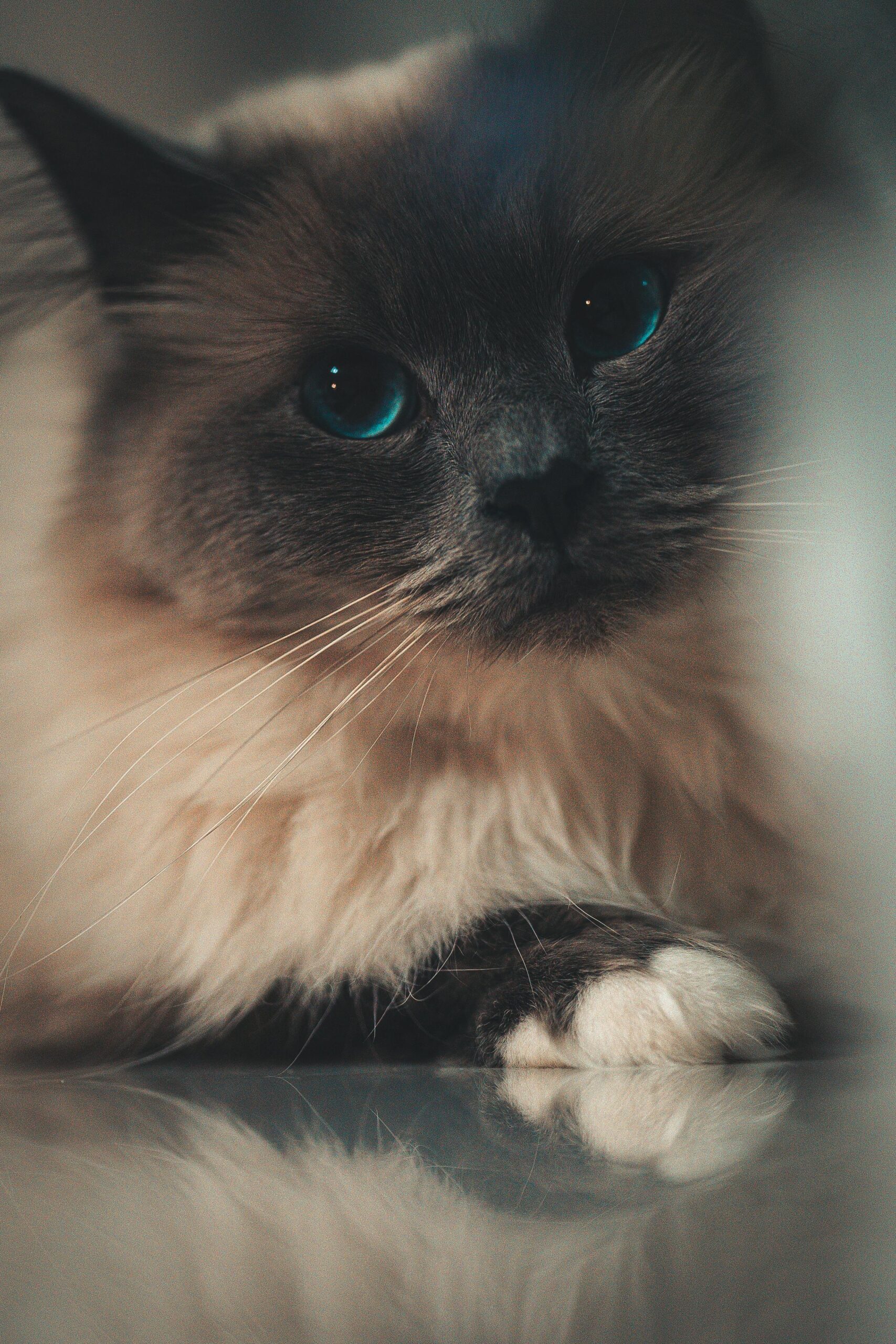

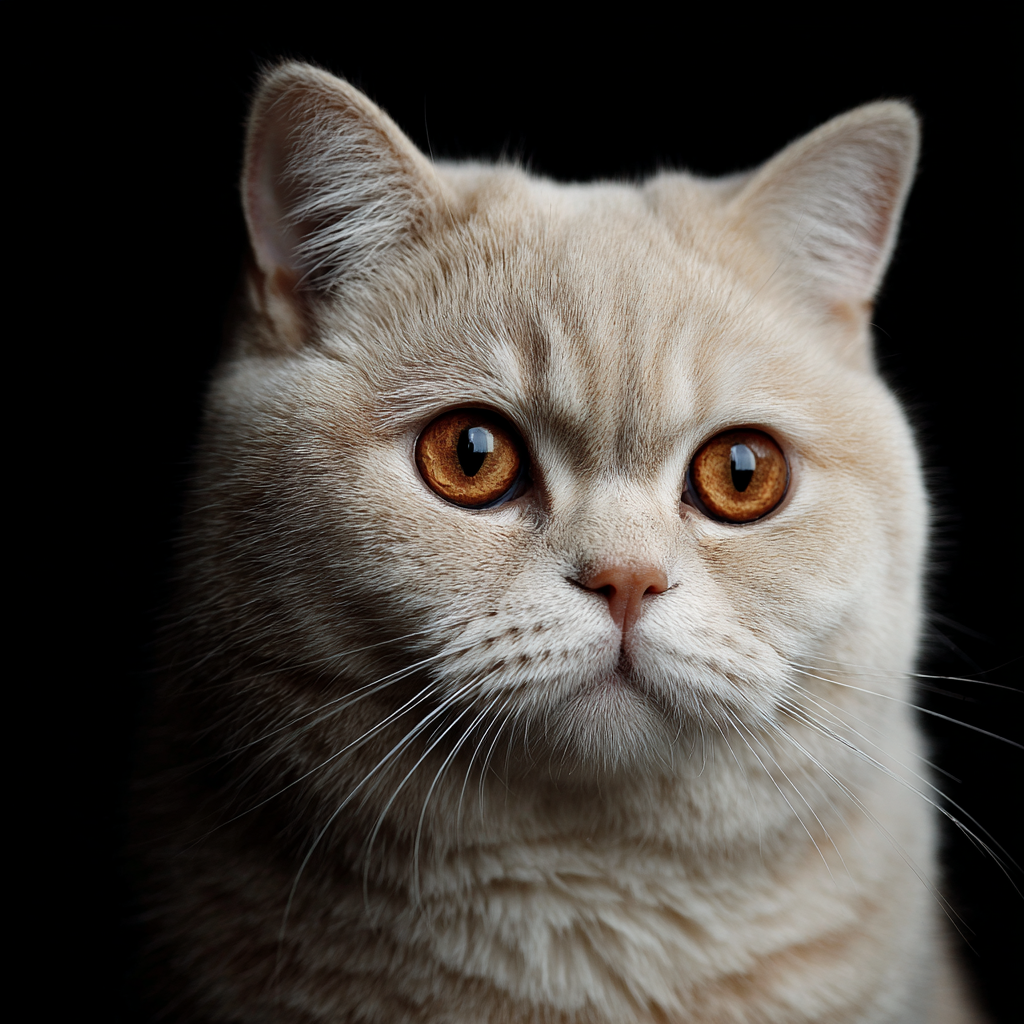
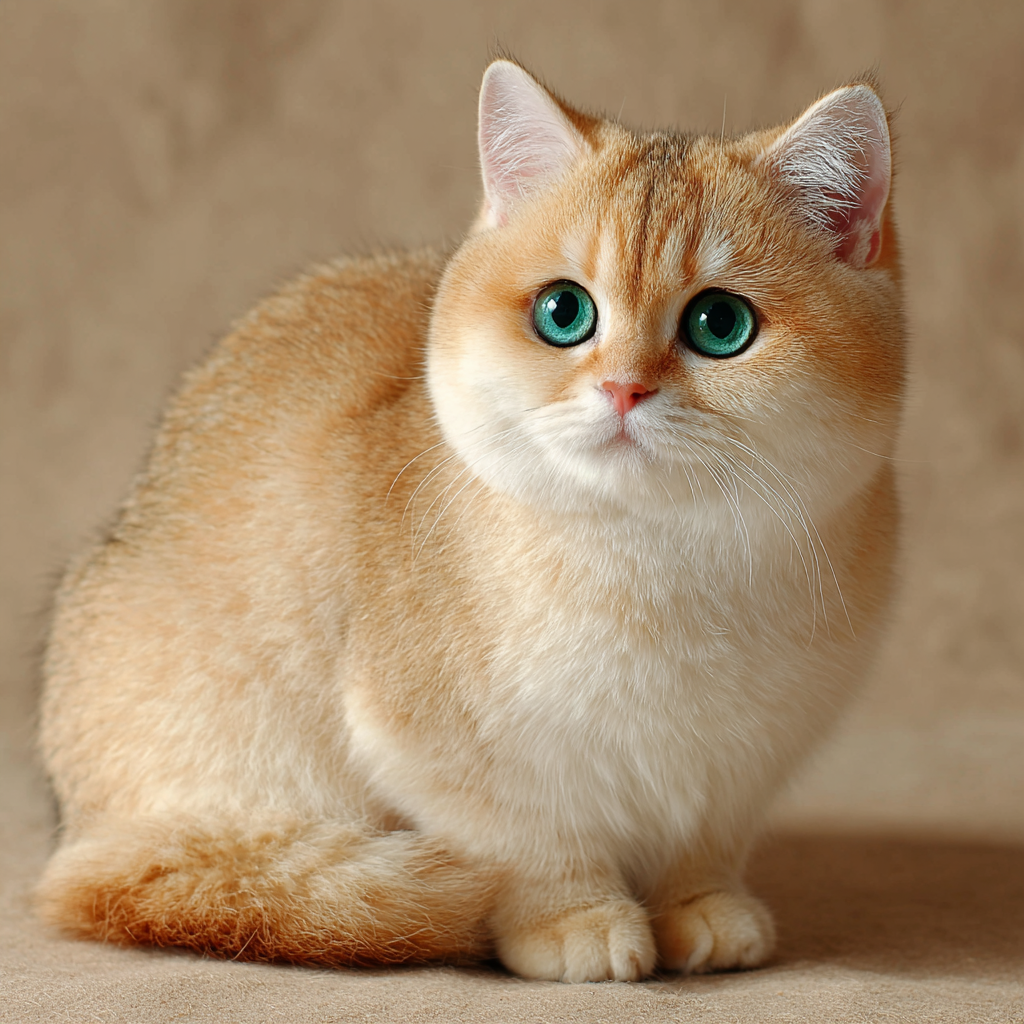
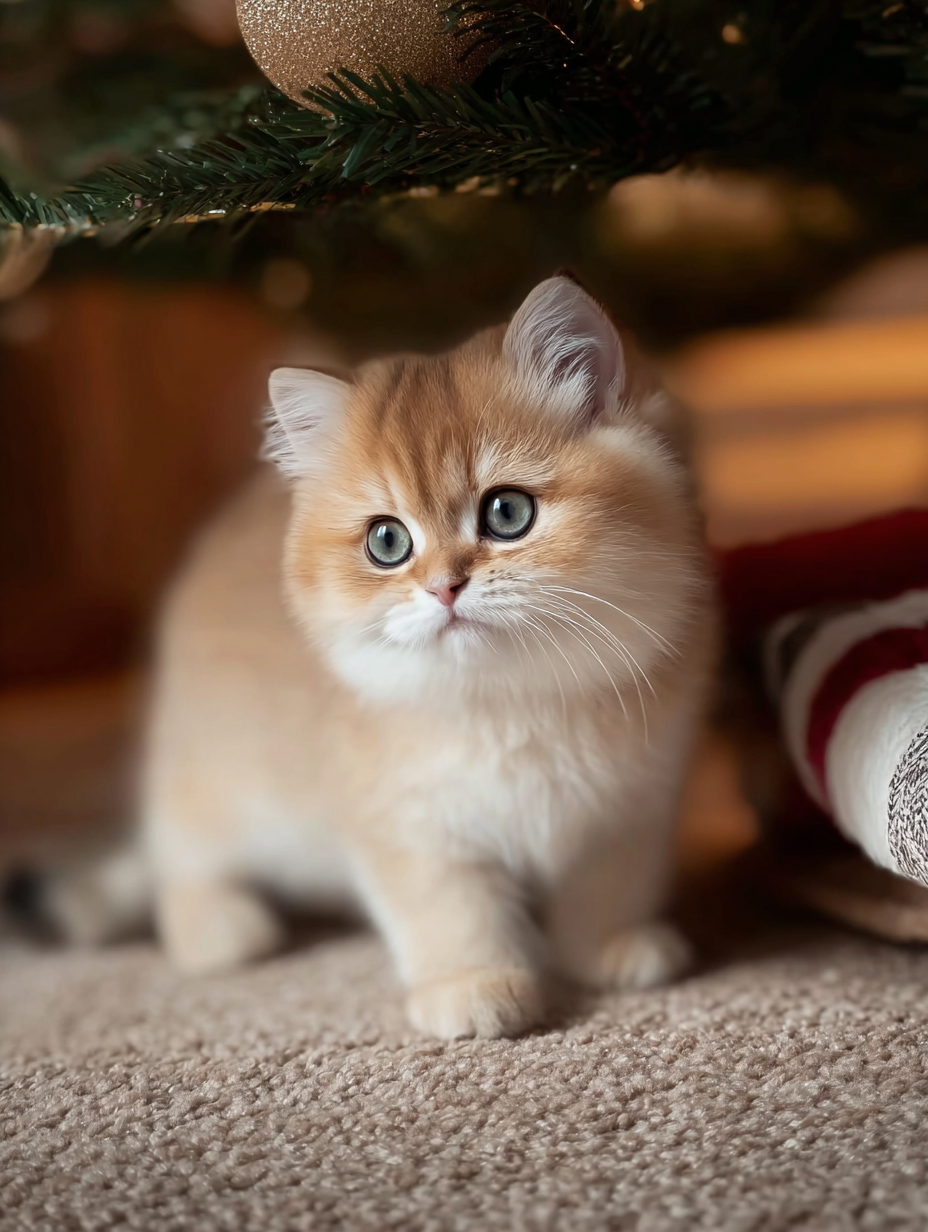
Read the Comments +